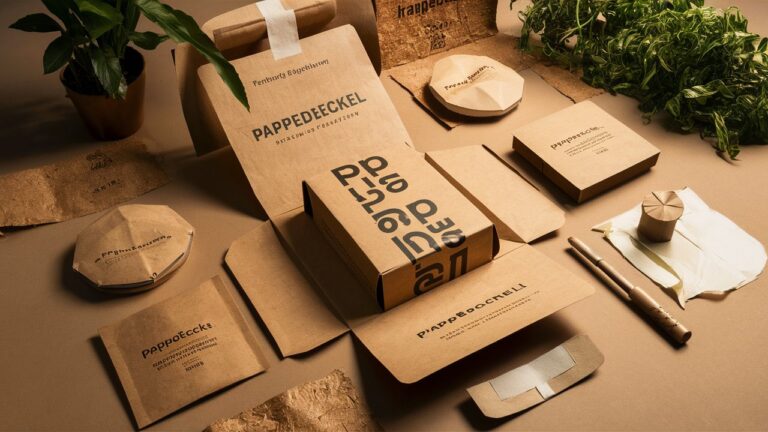Introduction
In a world increasingly conscious of environmental footprints, even the most modest everyday items are under scrutiny. One such unassuming yet impactful object is the Pappedeckel—the German term for “cardboard lid.” Though often overlooked, its applications span cafés, food packaging, branding, and eco-friendly design. This article illuminates the origins, benefits, and modern innovations of the Pappedeckel, exploring how such a small disc of cardboard can drive both utility and sustainability.
What Is a Pappedeckel? Understanding the Basics
The term Pappedeckel is a compound of two German words: “Pappe,” meaning cardboard or paperboard, and “Deckel,” meaning lid or cover. Thus, it literally translates to “cardboard lid”—commonly used to seal cups, containers, or food packaging Dot MagazinePeace Quarters. Whether circular or square, the Pappedeckel is typically made from recycled or virgin fiberboard, often pressed, coated, and die-cut for specific uses ModskinlolVucrex.
Historical Roots and Cultural Significance
Initially, cardboard lids served a purely functional role—sealing milk bottles, covering jars, or protecting homemade preserves. As industrial mass production grew, their use expanded into takeaway drinks and bakery packaging Peace Quartersiotavalley.com. In Germany in particular, these lids became cultural staples in cafés and beer gardens. Beyond serving as coasters or spill guards, in traditional beer-garden etiquette placing a Pappedeckel on your glass discreetly signals that you’re still drinking—an elegant blend of practicality and custom Cordless.ioiotavalley.com.
Practical Uses Across Industries
The Pappedeckel is incredibly versatile:
-
Food & Beverage: Commonly used as lids for coffee cups, soup bowls, bakery boxes, etc. Flashy MagazineModskinlol.
-
Branding: Its surface can carry logos, artwork, and QR codes—think mini portable billboards in cafés or events Peace QuartersCordless.io.
-
Packaging: Effective in protecting food items in delivery, serving as dividers or inserts in shipping—especially when lightweight and recyclable ModskinlolVucrex.
-
Craft & DIY: Repurposed for arts, educational projects, and home organization due to its texture and ease of handling Vucrex.
Sustainability & Environmental Impact
Recyclable & Compostable: Most Pappedeckel are made from fiberboard that’s biodegradable and fully recyclable—far preferable to plastic alternatives Peace QuartersVucrex.
Lower Carbon Footprint: Manufacturing cardboard requires less energy than plastic, especially when using recycled pulp ModskinlolVucrex.
Design for Compostability: Many modern designs avoid harmful coatings; some use biodegradable waxes, starch or PLA coatings, or even soy-based inks—enhancing compostability and eco-friendliness Modskinloliotavalley.com.
These traits make the Pappedeckel a natural fit in circular economies and aligned with regulatory movements, particularly across Europe, pushing against single-use plastics Cordless.ioiotavalley.com.
Modern Innovations & Future Trends
Today’s Pappedeckel isn’t just simpler and greener—it’s smarter:
-
Water-Resistant Coatings: Using biodegradable starches or waxes to maintain durability ModskinlolCordless.io.
-
Smart Branding: Incorporating QR codes, seasonal designs, or collectible artwork to elevate engagement and memory Cordless.ioiotavalley.com.
-
Regulatory Support: In regions where single-use plastics face bans, Pappedeckel emerges as a compliant, low-cost solution iotavalley.comCordless.io.
As consumer awareness grows and regulations tighten, we’re likely to see even broader adoption and enhanced design versatility—like embedded technology, sustainable materials, and creative uses.
Conclusion
The Pappedeckel may appear small and unremarkable, but its impact is anything but trivial. From cultural gestures in German cafés to evolving sustainable packaging solutions, its journey underscores the power of simple, thoughtful design. Lightweight, customizable, and eco-conscious, the cardboard lid is quietly shaping a more responsible future. Next time you encounter one—whether on a coffee cup or in a takeaway container—you’re seeing the intersection of design, culture, and sustainability in action.
Frequently Asked Questions (FAQ)
Q1: What is a Pappedeckel used for?
A Pappedeckel is a cardboard lid or cover commonly used for cups, jars, takeaway containers, bakery boxes, and even as coasters or brandable surfaces.
Q2: Is the Pappedeckel eco-friendly?
Yes—typically made from recyclable paperboard and often biodegradable. If untreated or treated with compostable coatings, it breaks down naturally, making it far superior to plastic lids.
Q3: How does it compare to plastic or silicone lids?
While plastic offers better waterproofing and durability, it’s environmentally harmful. Silicone is reusable but costlier. The Pappedeckel strikes a balance—moderate durability, very eco-friendly, and cost-effective for single-use scenarios iotavalley.comFlashy Magazine.
Q4: Can businesses customize Pappedeckel for branding?
Absolutely. Many businesses print logos, artwork, or even QR codes using eco-friendly inks, turning small lids into marketing assets Peace QuartersCordless.io.
Q5: What cultural importance does it have in Germany?
In German beer gardens, placing a Pappedeckel on your beer glass signals you’re still drinking—a subtle nonverbal etiquette. In cafés, it serves practical functions and reflects hospitality culture iotavalley.comCordless.io.
